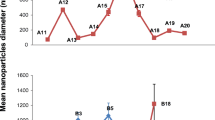Abstract
In order to increase the ocular absorption of carteolol, this antiglaucomatous drug was incorporated into either nanoparticles (NP) or nanocapsules (NC). The polymer used was poly(ε-caprolactone) (PCL). The dosage forms were tested on intraocular hypertensive-induced rabbits. Results are presented as the chronological variations of the intraocular pressure (IOP) in comparison with the commercial aqueous solution (Carteol eye drops). The therapeutic results (decrease in IOP) were much more pronounced with carteolol incorporated into the colloidal carriers than with the commercial eye drops. Further, NC displayed a better effect than NP because the drug was entrapped in the oily core of the carrier, thus more readily available to the eye. The incorporation of the drug into nanocapsules produced a decline in the cardiovascular side effects in comparison with aqueous eye drops, thus showing that the undesired noncorneal absorption was reduced. In conclusion, colloidal suspension made of poly(ε-caprolactone) could offer a good opportunity for ophthalmic delivery of drugs.
Similar content being viewed by others
REFERENCES
V. H. L. Lee and J. R. Robinson. Review: Topical ocular drug delivery. Recent developments and future challenges. J. Ocul. Pharm. 2:67–108 (1986).
S. C. Chang and V. H. L. Lee. Nasal and conjunctival contributions to the systemic absorption of topical timolol in the pigmented rabbit: Implications in the design and strategies to maximize the ratio of ocular to systemic absorption. J. Ocul. Pharm. 3:159–169 (1987).
D. Sirbat, C. Kholer, J. L. George, D. Mayeux, and J. P. Grilliat. Evaluation des effets systémiques cardiovasculaires et bronchiques d'un collyre β-bloquant. Ophtalmologie 2:213–218 (1988).
S. Ball. Congestive heart failure from betaxolol. Arch. Ophthalmol. 105:320 (1987).
K. Kishida and T. Otori. A quantitative study on the relationship between transcorneal permeability of drugs and their hydrophobicity. Jpn. J. Ophthalmol. 24:251–259 (1980).
L. Marchal-Heussler, H. Fessi, J. P. Devissaguet, M. Hoffman, and Ph. Maincent. Colloidal drug delivery systems for the eye. A comparison of the efficacy of three different polymers: Polyisobutylcyanoacrylate, polylactic-co-glycolic acid, polyepsilon-caprolactone. STP Pharma Sci. 2:98–104 (1992).
H. Fessi, F. Puisieux, J. P. Devissaguet, N. Ammoury, and S. Benita. Nanocapsules formation by interfacial polymer deposition following solvent displacement. Int. J. Pharm. 55:R1–R4 (1989).
P. Vareilles, P. Conquet, and J. C. Le Douarec. A method for the routine intraocular pressure (IOP) measurement in the rabbit: Range of IOP variations in this species. Exp. Eye Res. 24:269–282 (1977).
L. Marchal-Heussler, Ph. Maincent, M. Hoffman, J. Spittler, and P. Couvreur. Antiglaucomatous activity of betaxolol chlorhydrate sorbed onto different isobutylcyanoacrylate nanoparticle preparations. Int. J. Pharm. 58:115–122 (1990).
T. Harmia, J. Kreuter, P. Speiser, T. Boye, R. Gurny, and A. Kubis. Enhancement of the myotic response of rabbits with pilocarpine-loaded polybutylcyanoacrylate nanoparticles. Int. J. Pharm. 33:187–193 (1986).
P. Ashton, S. K. Podder, and V. H. L. Lee. Formulation influence on conjunctival penetration of four beta blockers in the pigmented rabbit: A comparison with corneal penetration. Pharm. Res. 9:1166–1174 (1991).
S. D. Troster, U. Muller, and J. Kreuter. Modification of the body distribution of poly(methylmethacrylate) nanoparticles in rats by coating with surfactants. Int. J. Pharm. 61:85–100 (1990).
N. Ammoury, H. Fessi, J. P. Devissaguet, F. Puisieux, and S. Benita. Physicochemical characterization of polymeric nanocapsules and in vitro release evaluation of indomethacin as a drug model. STP Pharma 5:647–651 (1989).
S. J. Ory, C. B. Hammond, S. G. Yancy, R. W. Hendren, and C. G. Pitt. The effect of a biodegradable contraceptive capsule (Capronor) containing levonorgestrel on gonadotropin, estrogen, and progesterone levels. Am. J. Obstet. Gynecol. 5:600–605 (1983).
Author information
Authors and Affiliations
Rights and permissions
About this article
Cite this article
Marchal-Heussler, L., Sirbat, D., Hoffman, M. et al. Poly(ε-Caprolactone) Nanocapsules in Carteolol Ophthalmic Delivery. Pharm Res 10, 386–390 (1993). https://doi.org/10.1023/A:1018936205485
Issue Date:
DOI: https://doi.org/10.1023/A:1018936205485




